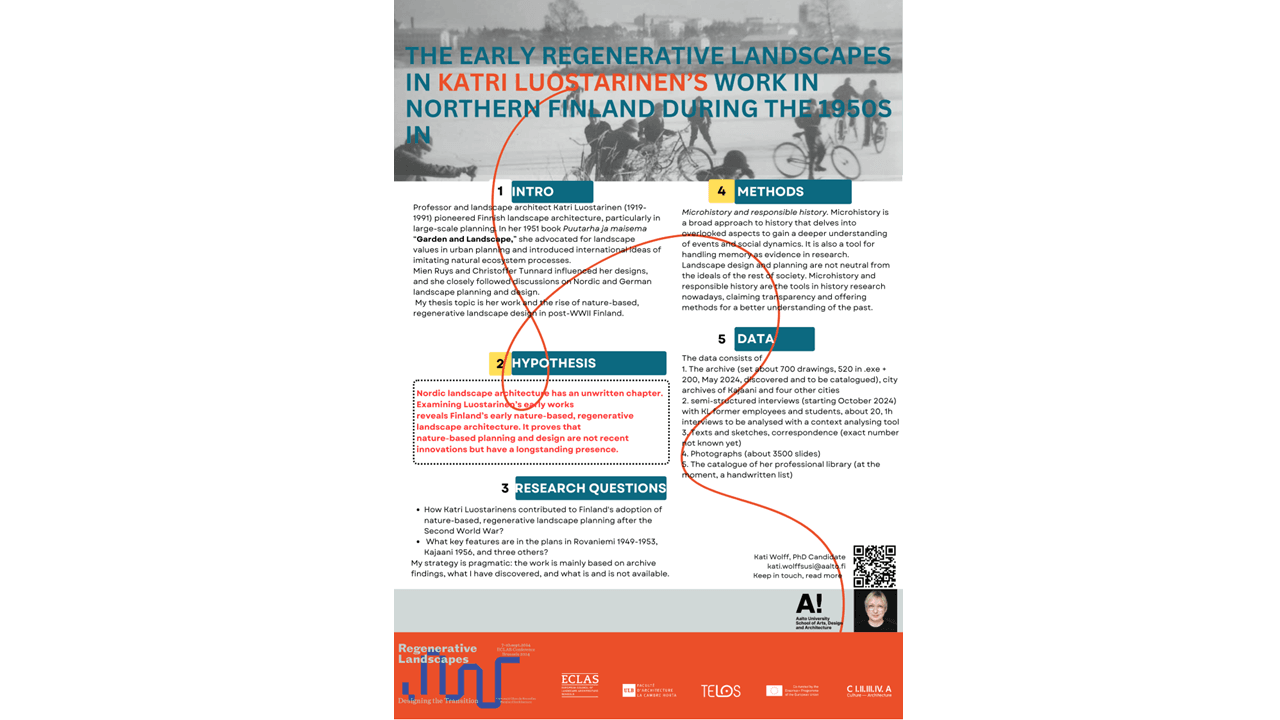Landscape architect Katri Luostarinen (1915-1991) and the rise of nature-based, regenerative landscape design in post-WWII Finland.
This text is for ECLAS2024, Regenerative Landscapes. Designing the Transition https://conference.eclas.org/ presentation, on September 7th at
Université Libre de Bruxelles (ULB), Faculté d’Architecture La Cambre Horta, Place Eugène Flagey 19, 1050 Bruxelles, Belgium
Dear readers, I started my PhD, at Aalto University, School of Arts, Design and Architecture, Landscape architecture in Helsinki, in January 2024, supervisor Professor Ranja Hautamäki and thesis advisor Julia Donner, PhD (Art History) with a working title
Landscape architect Katri Luostarinen (1915-1991) and the rise of nature-based, regenerative landscape design in post-WWII Finland.
more specificly The Early Regeneretive Landscapes in Katri Luostarinens work in Northern Finland during the 1950s

Professor and landscape architect, Katri Luostarinen (1915-1991) pioneered Finnish landscape architecture, particularly in large-scale planning. In her 1951 book puutarha ja maisema “Garden and Landscape,” she advocated for landscape values in urban planning and introduced international ideas of imitating natural ecosystem processes.
Her early influence came from the German speaking world, but designers like Mien Ruys and Christoffer Tunnard influenced her, too, and she closely followed discussions on Nordic and German landscape planning and design during her whole career. She was the grounding member of the Society of Finnish Garden Architects and the first secretary, later she represented Finland in IFLA, the International Federation of Landscape Architects.
My hyphothesis is that Nordic landscape architecture has this unwritten chapter. Examining Luostarinen’s early works reveals Finland’s early nature-based, regenerative landscape architecture. It proves that nature-based planning and design are not recent innovations but have a longstanding presence.
I didn’t personally know or ever meet Katri Luostarinen. My journey with her started around 2008 while doing a consultant work and transferring a collection of Luostarinen drawings to the Museum of Finnish Architecture 2009-2010. She has fascinated me ever since. Last summer, 2023, the Luostarinen family kindly donated a collection of slides to me for cataloguing, which I am currently going through. There are about 3500 moisture-damaged images. There were the books and papers, too. I spent May 2024 cataloguing Luostarinens library in a remote summer cottage, before the books were thrown into the bin due to extreme mould.


I found myself in a situation where someone should write her story. Why not me, then? Now is the chance to learn more about her work. I am not a young academic. I have a background as a university lecturer in Helsinki, I've been off academia for over 10 years, living in Luxembourg. I've always thought that PhD is something for an young academic, a ticket to the party, so to say. Therefore, I was pretty hesitant about starting the work. But, okay, this is a way of creating knowledge, so why not, when possible. And yes, it is a treat.
What I am about to do is to investigate how Katri Luostarinen contributed to adopting nature-based, regenerative landscape planning in Finland after the Second World War.
- What key features are there in the plans in Rovaniemi 1949-1953, and Kajaani 1956?
- Could Kajaani-Kaupunginlampi be considered the inaugural regenerative landscape plan in Finland?
The core of my research strategy is pragmatism, emphasizing the use of archive findings and uncovering new information. Katri Luostarinens whole career and life, also as the first professor in landscape architecture would be too big task for a PhD.
My interest lies in early regenerative landscape projects in Northern Finland during the 1950s, the first projects she did professionally. Finnish forest suburbs have been studied in post-war modernist planning by both architecture and landscape architecture. However, the theme of regenerative, understood as promoting long-term sustainability, increasing biodiversity and improving resilience on a larger scale adapted to industrial landscapes, has yet to be focused on.
The research method I have borrowed from historians. I adopt a micro-history (Classics like Giovanni Levi and Carlo Ginzburg, Italian historians) approach and engage in responsible history (like Anthony Baets). Microhistory is a broad approach to history that delves into overlooked aspects to gain a deeper understanding of events and social dynamics. Microhistory zooms in on a particular family, group, or individual within the broader historical context. The connection between writing about individuals and microhistory poses challenges in discussing general concepts while focusing on individual descriptions. It poses a question: How can one avoid generalisations and still capture the bigger picture when describing situations and individuals?
This work is about a person, Katri, and her references, ideas and how she influenced in following generations. Microhistory is a tool to handle memory as a evidence in research and suitable also for reflecting Luostarinens study time in Berlin 1943-1944 under her teacher, Professor Heinrich Friedrich Wiepking-Jürgesmann (1891-1973). However, Luostarinens library seems to show stong proof of broader international interests
Landscape design and planning is not a neutral from the ideals of the rest of society. Microhistory and responsible history are the tools in history research claiming transparency and offering methods for better understanding the past. They give us a perspective where a short-lived event reveals a long-lived construct, e.g. a person's history can be used to examine macro-level phenomena.


Kati Wolff PhD Candidate, 2024-
https://research.aalto.fi/en/persons/kati-wolff-susi Aalto University, Helsinki
In the monthly publication of the Finnish Association of Architects, SAFA 14.6.2024: https://www.safa.fi/arkkitehtiuutiset/puheenvuoro-luontopohjaisella-kaupunkisuunnittelulla-on-pitka-historia/
